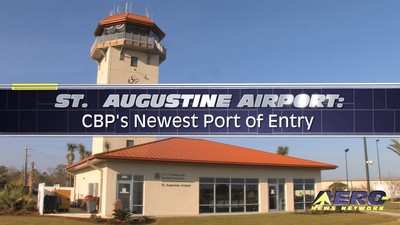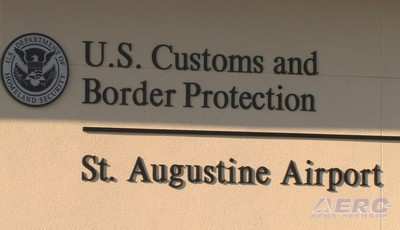Tue, Apr 14, 2009
Transitioning into and out of US Airspace can often be something
of a chore but an aggressive and expert effort by the St. Augustine
Airport has resulted in a new way to ease the issues in entering
and leaving the USA via a recently dedicated fee-based Port Of
Entry located near the base of the Control Tower at one of the best
airports in the SouthEast USA... if not the country.

ANN and Aero-TV were pleased to be invited to join in the
dedication of the new facility a few days ago and took the time to
learn about what it took for St. Augustine to land such a "plus"
and further help to propel the development of this incredibly
progressive GA airport.

US Customs and Border Protection, or CBP, is reportedly one of
the Department of Homeland Security’s largest and most
complex components, with a priority mission of keeping terrorists
and their weapons out of the US. It also has a responsibility for
securing and facilitating trade and travel while enforcing hundreds
of US regulations, including immigration and drug laws. CBP guards
nearly 7,000 miles of land border the United States shares with
Canada and Mexico as well as 2000 miles of coastal waters
surrounding the Florida peninsula and off the coast of Southern
California. The agency also protects 95,000 miles of maritime
border in partnership with the United States Coast Guard. To secure
this vast area, more than 17,000 CBP Border Patrol agents, 1,000
CBP Air and Marine agents, and almost 22,000 CBP officers and
agriculture specialists, together with the nation’s largest
law enforcement canine program, stand guard along America’s
front line.

CBP officers monitor America’s borders via official 'Ports
of Entry,' while CBP’s Border Patrol agents prevent illegal
entry into the United States of people and contraband between the
ports of entry. Having a Port of entry is a major boost for any
airport and a serious facilitator to trade and travel. Some of
these PoEs are funded through tax dollars, while others, built for
convenience and in keeping with a new move toward a User fee based
initiative are fee-based. A CBP-defined 'User Fee Airport' is a
location designated under 19 USC sec 58b where a fee is charged for
the use of CBP services. Such is the case with the new facility at
St. Augustine... though operators in the region expect that the fee
structure will be offset dramatically by the more economical
convenience and local nature of being able to utilize the
facilities at KSGJ.

CBP describes the Port of St. Augustine "as an airport
environment with both passenger and cargo processing
responsibilities. Port personnel are the face at the border for
most cargo and visitors entering the United States. Here CBP
enforces the import and export laws and regulations of the U.S.
federal government and conducts admissibility activities. The Port
also performs agriculture inspections to protect the USA from
potential carriers of animal and plant pests or diseases that could
cause serious damage to America's crops, livestock, pets, and the
environment. This port is designated as a Class A Port of entry for
all aliens."

More News
Bolen Issues Statement Reinforcing Need To Reopen Government The National Business Aviation Association’s President and CEO issued the statement below in response to further >[...]
Output May Reach Its Best Since 2018 Despite Trailing Behind Airbus Boeing delivered 53 jets in October, bringing its 2025 total to 493 aircraft and marking its strongest output si>[...]
Low-Cost Airline Admits “Substantial Doubt” It Can Stay Airborne Spirit Airlines has once again found itself in financial trouble, this time less than a year after clai>[...]
Travelers Leaving Changi Will Soon Pay for Sustainable Fuel Starting April 2026, passengers flying out of Singapore will find a new fee tucked into their tickets: a Sustainable Avi>[...]
Pilot Was Having Difficulty Controlling The Airplane’S Rudder Pedals Due To His Physical Stature Analysis: The pilot was having difficulty controlling the airplane’s ru>[...]
 NBAA Responds To GA/BA Operational Restrictions
NBAA Responds To GA/BA Operational Restrictions Boeing Deliveries Surge to Pre-Pandemic Levels
Boeing Deliveries Surge to Pre-Pandemic Levels Spirit Forecasts Financial Turbulence
Spirit Forecasts Financial Turbulence Singapore Adds a Price Tag to Going Green
Singapore Adds a Price Tag to Going Green NTSB Final Report: Arlie L Raber III Challenger 1
NTSB Final Report: Arlie L Raber III Challenger 1







